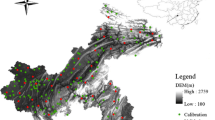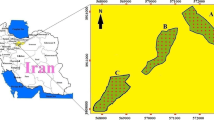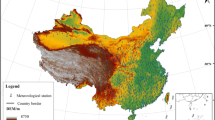Abstract
Soil temperature variability data provide valuable information on understanding land-surface ecosystem processes and climate change. This study developed and analyzed a spatial dataset of monthly mean soil temperature at a depth of 10 cm over a complex topographical region in southwestern China. The records were measured at 83 stations during the period of 1961–2000. Nine approaches were compared for interpolating soil temperature. The accuracy indicators were root mean square error (RMSE), modelling efficiency (ME), and coefficient of residual mass (CRM). The results indicated that thin plate spline with latitude, longitude, and elevation gave the best performance with RMSE varying between 0.425 and 0.592 °C, ME between 0.895 and 0.947, and CRM between −0.007 and 0.001. A spatial database was developed based on the best model. The dataset showed that larger seasonal changes of soil temperature were from autumn to winter over the region. The northern and eastern areas with hilly and low-middle mountains experienced larger seasonal changes.





Similar content being viewed by others
References
Agnew MD, Palutikof JP (2000) GIS-based construction of baseline climatologies for the Mediterranean using terrain variables. Clim Res 14:115–127
Benavides R, Montes F, Rubio A, Osoro K (2007) Geostatistical modelling of air temperature in mountainous region of Northern Spain. Agric For Meteorol 146:173–188
Bilgili M (2011) The use of artificial neural networks for forecasting the monthly mean soil temperatures in Adana, Turkey. Turk J Agric For 35:83–93
Burrough PA (1986) Principals of geographical information systems for land resources assessment. Clarendon Press, Oxford
Chaplot V, Darboux F, Bourennane H, Leguédois S, Silvera N, Phachomphon K (2006) Accuracy of interpolation techniques for the derivation of digital elevation models in relation to landform types and data density. Geomorphology 77:126–141
Chiles JP, Delfiner P (1999) Geostatistics: modeling spatial uncertainty. John Wiley and Sons, New York
Daly C (2006) Guidelines for assessing the suitability of spatial climate data sets. Int J Climatol 26:707–721
Dodson R, Marks D (1997) Daily air temperature interpolated at high spatial resolution over a large mountainous region. Clim Res 8:1–20
FAO/IIASA/ISRIC/ISS-CAS/JRC (2009) Harmonized world soil database (version 1.1). FAO, Rome, Italy and IIASA, Laxenburg, Austria
George RK (2001) Prediction of soil temperature by using artificial neural networks algorithms. Nonlinear Anal 47:1737–1748
Hartkamp AD, De Beurs K, Stein A, White JW (1999) Interpolation techniques for climate variables. NRG-GIS Series 99–01, CIMMYT, Mexico, D.F
Hong Y, Nix HA, Hutchinson MF, Booth TH (2005) Spatial interpolation of monthly mean climate data for China. Int J Climatol 25:1369–1379
Hu Q, Feng S (2003) A daily soil temperature dataset and soil temperature climatology of the contiguous United States. J Appl Meteorol 42:1139–1156
Huang SH, Cheng CH, Wu WJ (2010) Possible impacts of climate change on rice insect pests and management tactics in Taiwan. Crop Environ Bioinforma 7:269–279
Hudson G, Wackernagel H (1994) Mapping temperature using kriging with external drift: theory and example from Scotland. Int J Climatol 14:77–91
Hutchinson MF (1991) The application of thin plate smoothing splines to continent-wide data assimilation. In: Jasper J (ed) Data assimilation systems: BMRC Research Report No. 27. Bureau of Meteorology, Melbourne, pp 104–113
Hutchinson MF (1995) Interpolating mean rainfall using thin plate smoothing splines. Int J Geogr Inf Syst 9:385–403
Hutchinson MF (2001) ANUSPLIN user guide. Australian National Uuniversity, Canberra
IPCC (2001) Climate change 2001: The scientific basis. Contribution of Working Group I to the Third Assessment Report of the Intergovernmental Panel on Climate Change (IPCC). Houghton JT, Ding Yo, Griggs DJ, Noguer M, van der Linden PJ, Xiaosu D (eds) Cambridge Univ. Press, UK 944
Isaaks EH, Srivastava RM (1989) An introduction to applied geostatistics. Oxford University Press, New York
Jarvis CH, Stuart N (2001) A comparison among strategies for interpolating maximum and minimum daily air temperatures. Part II: the interaction between number of guiding variables and the type of interpolation method. J Appl Meteorol 40:1075–7084
Kurtzman D, Kadmon R (1999) Mapping of temperature variables in Israel: a comparison of different interpolation methods. Clim Res 13:33–43
Kwon YS, Chuna N, Bae MJ, Li FQ, Chon TS, Park YS (2012) Effects of meteorological factors and global warming on rice insect pests in Korea. J Asia Pac Entomol 15:507–515
Lawton JH (1995) The response of insects to environmental change. In: Harrington R, Stork NE (eds) Insects in a changing environment. Academic Press, London, pp 3–26
Lee R (1978) Forest microchmatology. Columbia University Press, New York
MacLean JSF, Ayres MP (1985) Estimation of soil temperature from climatic variables at barrow, Alaska, U.S.A. Arct Antarct Alp Res 17:425–432
McDonald A, Riha S, DiTommaso A, DeGaetano A (2009) Climate change and the geography of weed damage: analysis of U.S. maize systems suggests the potential for significant range transformations. Agric Ecosyst Environ 130:131–140
McMichael BL, Burke JJ (1998) Soil temperature and root growth. HortSci 33:947–951
Olesen JE, Bindi M (2002) Consequences of climate change for European agricultural productivity, land use and policy. Eur J Agron 16:239–262
Olesen JE, Trnka M, Kersebaum KC, Skjela AO, Seguin B, Peltonen-Sainio P, Rossi F, Kozyra J, Micale F (2011) Impacts and adaptation of European crop production systems to climate change. Eur J Agron 34:95–112
Ozturk M, Salman O, Koc M (2011) Artificial neural network model for estimating the soil temperature. Can J Soil Sci 91:551–562
Phillips DL, Dolph J, Marks D (1992) A comparison of geostatistical procedures for spatial analysis of precipitation in mountainous terrain. Agric For Meteorol 58:119–141
QX/T 57–2007 (2007) Specifications for surface meteorological observation-part 13: measurement of soil temperature. China Meteorological Press, Beijing (in Chinese)
Rötter RP, Palosuo T, Pirttioja NK, Dubrovsky M, Salo T, Fronzek S, Aikasalo R, Trnka M, Ristolainen A, Carter TR (2011) What would happen to barley production in Finland if global warming exceeded 4 °C? A model-base assessment. Eur J Agron 35:205–214
Roudier P, Sultan B, Quirion P, Berg A (2011) The impact of future climate change on West African crop yields: what does the recent literature say? Global Environ Chang 21:1073–1083
Stahl K, Moore RD, Floyer JA, Asplin MG, McKendry IG (2006) Comparison of approaches for spatial interpolation of daily air temperature in a large region with complex topography and highly variable station density. Agric For Meteorol 139:224–236
Štěpánek P (2008) AnClim - software for time series analysis. http://www.climahom.eu/AnClim.html
Stoutjesdijk P, Barkman JJ (1992) Microclimate, vegetation and fauna. Opulus Press, Sweden, p 216
Talmi A, Gilat G (1977) Method for smooth approximation of data. J Comput Phys 23:93–123
Tao FL, Yokozawa M, Xu YL, Hayashi Y, Zhang Z (2006) Climate changes and trends in phenology and yields of field crops in China, 1981–2000. Agric For Meteorol 138:82–92
Thornton PE, Running SW, White MA (1997) Generating surfaces of daily meteorological variables over large regions of complex terrain. J Hydrol 190:214–251
Toy TJ, Kuhaida AJ, Munson BE (1978) The prediction of mean monthly soil temperature from mean monthly air temperature. Soil Sci 126:181–189
Vicente-Serrano SM, Saz-Sanchez MA, Cuadrat JM (2003) Comparative analysis of interpolation methods in the middle Ebro Valley (Spain): application to annual precipitation and temperature. Clim Res 24:161–180
Webster R, Oliver A (1992) Sample adequately to estimate variograms of soil properties. J Soil Sci 43:177–192
Webster R, Oliver MA (2001) Geostatistics for environmental scientists. John Wiley and Sons, Brisbane
Wu W, Tang XP, Guo NJ, Yang C, Liu HB, Shang YF (2013a) Spatiotemporal modeling of monthly soil temperature using artificial neural networks. Theor Appl Climatol 113:481–494
Wu W, Tang XP, Yang C, Guo NJ, Liu HB (2013b) Spatial estimation of monthly mean daily sunshine hours and solar radiation across mainland China. Renew Energy 57:546–553
Zheng DL, Hunt JER, Running SW (1993) A daily soil temperature model based on air temperature and precipitation for continental applications. Clim Res 2:183–191
Acknowledgments
The authors thank Guizhou Soil and Fertilizer Institute for providing the soil temperature data.
Author information
Authors and Affiliations
Corresponding author
Rights and permissions
About this article
Cite this article
Wu, W., Tang, XP., Ma, XQ. et al. A comparison of spatial interpolation methods for soil temperature over a complex topographical region. Theor Appl Climatol 125, 657–667 (2016). https://doi.org/10.1007/s00704-015-1531-x
Received:
Accepted:
Published:
Issue Date:
DOI: https://doi.org/10.1007/s00704-015-1531-x




